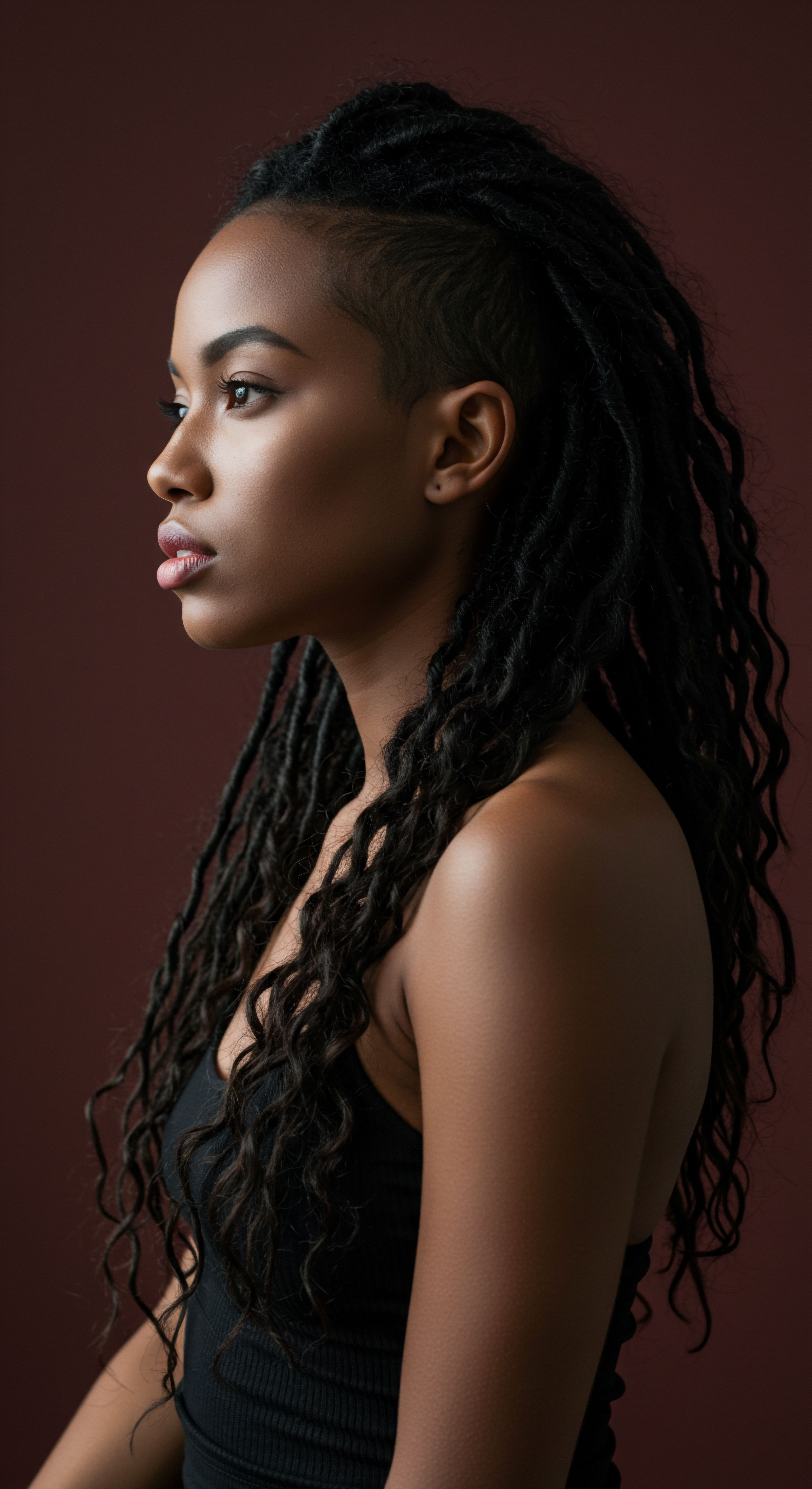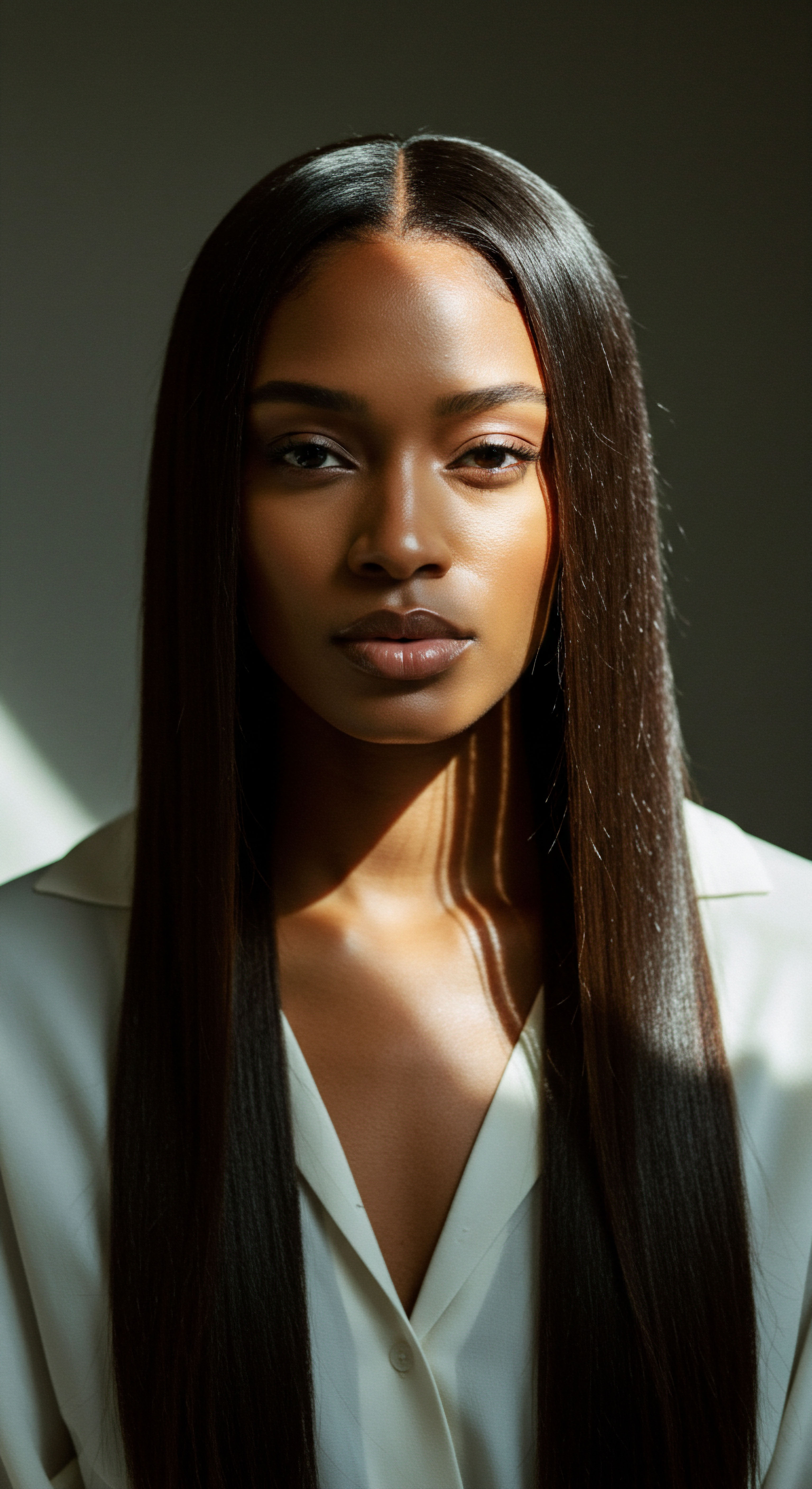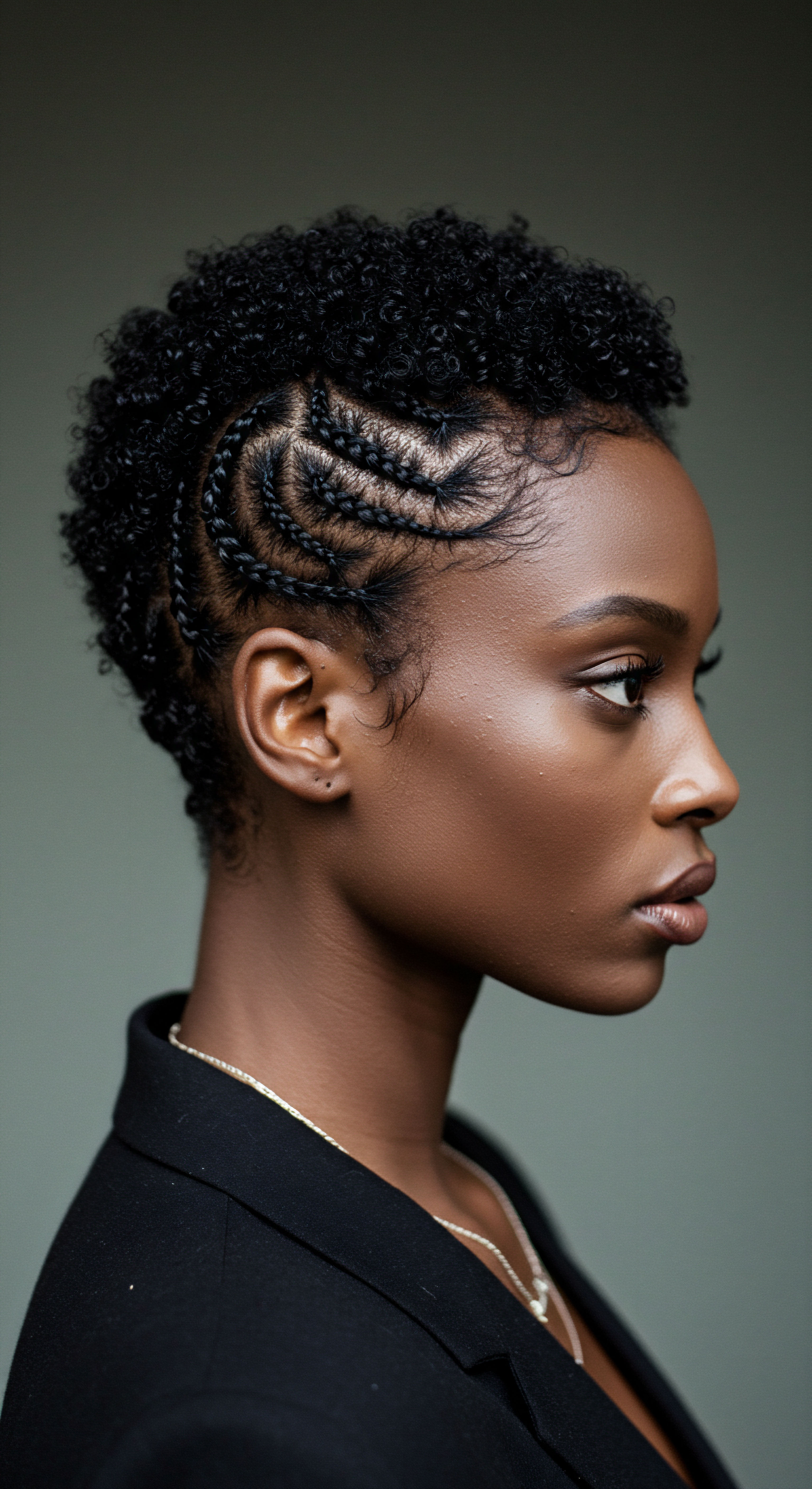
Roots
There is a quiet wonder in the way our hair rests as the world outside softens into night. For those with textured strands, this nightly repose is not merely a period of stillness; it is a profound opportunity for restoration, a time when scientific principles align with ancestral wisdom to safeguard the delicate architecture of each coil and curl. We often think of hair care as an active, daytime pursuit, yet the hours of slumber hold a distinct significance, shaping the vitality and resilience of our hair from its very core. Understanding this nocturnal dynamic begins with a gentle journey into the fundamental nature of textured hair itself.
The intrinsic characteristics of textured hair present unique considerations for its wellbeing, particularly during periods of unconscious movement. Unlike straight strands, which typically possess a more uniform, circular cross-section, coily and kinky hair emerges from an elliptical follicle. This distinct shape contributes to the hair shaft’s natural tendency to curl and coil, creating points of vulnerability along its length.
The cuticle, the outermost protective layer of the hair, does not lie as flat and smooth on highly textured hair as it might on straighter hair. Instead, these overlapping scales are often slightly raised, particularly at the curves of each coil, rendering them more susceptible to external friction and environmental stressors.

The Intricacies of Hair’s Structure
Each strand of hair, regardless of its curl pattern, is a complex protein filament primarily composed of keratin. However, the distribution and arrangement of disulfide bonds within the cortex, the hair’s inner layer, play a considerable part in determining its curl pattern. In textured hair, these bonds are distributed unevenly, contributing to the hair’s characteristic bends and twists. This structural particularity means that while textured hair can be incredibly strong in its natural state, its many points of curvature also present opportunities for mechanical damage.
Textured hair’s unique elliptical follicle and raised cuticle scales necessitate specialized care to preserve its inherent strength.
The natural lipid barrier, a delicate film that coats the hair shaft, provides a measure of protection against moisture loss and environmental assault. For textured hair, maintaining this barrier is paramount, as its structural characteristics can allow for a quicker evaporation of moisture. The physics of friction, often underestimated, exerts a considerable influence on the integrity of coily and kinky strands. When hair rubs against surfaces, particularly during sleep, the raised cuticles can snag, lift, or even break, leading to frizz, dullness, and eventual fracture.

Why Does Friction Matter to Hair?
Friction is a force that opposes motion between surfaces in contact. For hair, this contact occurs constantly ❉ with clothing, hands, and perhaps most notably, with bedding during sleep. The microscopic landscape of a cotton pillowcase, for instance, is far from smooth.
Its fibers, when magnified, appear rough and absorbent, creating a highly frictional environment for delicate hair strands. This constant rubbing can lead to the lifting of the cuticle layers, exposing the cortex and accelerating moisture loss and structural degradation.
- Cuticle Integrity ❉ The outermost layer of hair, the cuticle, acts as a protective shield, and its disruption compromises hair health.
- Mechanical Stress ❉ Tossing and turning during sleep applies repetitive stress to hair, particularly at points of curvature.
- Moisture Retention ❉ A compromised cuticle struggles to hold moisture, leading to dryness and brittleness.

Ritual
As daylight fades and the world prepares for slumber, a quiet, purposeful transformation can begin for textured hair. This period, often overlooked in the broader conversation of hair wellness, offers a profound opportunity to nurture and protect. It is a time when gentle, deliberate actions can counteract the daily stresses and prepare strands for a vibrant tomorrow. The practice of nocturnal care moves beyond mere habit; it becomes a conscious act of preservation, drawing upon scientific principles to shield and sustain the hair’s delicate structure.
The essence of effective nighttime care for textured hair lies in minimizing mechanical stress and maximizing moisture retention. During sleep, our bodies shift and move, and our hair, in constant contact with bedding, is subjected to forces that can lead to tangles, breakage, and the loss of essential hydration. The science behind nocturnal care seeks to mitigate these factors, creating a protective microenvironment for the hair shaft.

The Nighttime Sanctuary ❉ Essential Sleep Protection
The choice of sleep surface or hair covering plays a significant part in the efficacy of nocturnal care. Traditional cotton pillowcases, while comfortable for the skin, can be particularly detrimental to textured hair. The absorbent nature of cotton actively wicks moisture away from the hair, leading to dryness and brittleness. Furthermore, the rough fibers of cotton create considerable friction against the hair shaft, causing the delicate cuticle layers to lift, snag, and ultimately break.
Opting for smooth, non-absorbent materials like silk or satin during sleep is a scientifically supported method to reduce friction and preserve hair’s moisture.
Conversely, materials like silk and satin possess a smoother surface with a lower coefficient of friction. When hair glides across these fabrics, the resistance is significantly reduced, minimizing cuticle disruption and preventing mechanical damage. Beyond reducing friction, these materials are less absorbent than cotton, meaning they do not draw moisture from the hair, allowing products applied before bed to work more effectively and keeping the hair hydrated throughout the night.
| Material Cotton |
| Friction Coefficient High |
| Moisture Absorption High |
| Impact on Hair Increased breakage, dryness, frizz |
| Material Silk |
| Friction Coefficient Low |
| Moisture Absorption Low |
| Impact on Hair Reduced breakage, moisture retention |
| Material Satin (Polyester) |
| Friction Coefficient Low |
| Moisture Absorption Low |
| Impact on Hair Reduced breakage, moisture retention |
| Material Smooth, non-absorbent fabrics provide superior protection for textured hair during sleep. |

Ingredient Choices for Overnight Replenishment
The products chosen for nighttime application are as important as the protective covering. Ingredients that support moisture retention and structural integrity are key. Humectants, such as glycerin or hyaluronic acid, draw water from the air and hold it within the hair shaft, contributing to lasting hydration.
Emollients, like various botanical oils (jojoba, argan, shea butter), form a protective seal on the hair’s surface, preventing moisture loss and providing a smooth feel. Proteins, when used judiciously, can temporarily strengthen the hair shaft, particularly if it has been compromised.
A personalized nighttime regimen might involve a light leave-in conditioner or a moisturizing cream, applied to slightly damp hair. This application creates a reservoir of hydration that the protective covering then helps to seal in. For some, a light oil can be applied to the ends to further shield them from friction. The key is to select products that complement the hair’s porosity and density, avoiding heavy formulations that could lead to build-up or weigh down the hair.

What Are the Best Practices for Pre-Sleep Hair Preparation?
Prior to covering the hair, gentle detangling is often beneficial. Dry, tangled hair is far more susceptible to breakage during sleep. Using a wide-tooth comb or fingers, hair can be carefully separated, starting from the ends and working upwards. This prepares the strands for a more serene night, minimizing the chances of knots forming overnight.
Securing the hair in a loose style, such as a pineapple (a high, loose ponytail), a few large braids, or twists, further reduces direct contact with the pillow and preserves the curl pattern. This strategic preparation, combined with the right protective material, forms the foundation of a robust nocturnal care ritual.
- Gentle Detangling ❉ Use a wide-tooth comb or fingers to remove tangles before bed, reducing breakage.
- Moisture Application ❉ Apply a leave-in conditioner or light oil to lock in hydration.
- Protective Styling ❉ Create loose braids, twists, or a pineapple to minimize friction and maintain curl integrity.

Relay
To truly grasp the scientific imperative behind nocturnal care for textured hair, one must look beyond surface-level observations and delve into the biomechanical and hydro-thermal forces at play during sleep. It is a nuanced interplay of physics, chemistry, and physiology that dictates the hair’s condition upon waking. The night, far from being a passive period, presents a unique set of challenges and opportunities for hair vitality, particularly for those with complex curl patterns.
The very act of tossing and turning, which is a natural component of the sleep cycle, subjects hair to considerable mechanical stress. For textured hair, where the hair shaft frequently changes direction, these movements translate into repeated bending, stretching, and compression. Each bend point becomes a potential stress concentrator, particularly vulnerable to fracture. The elasticity and tensile strength of textured hair, while considerable, can be compromised over time by this cumulative micro-trauma.

The Biomechanics of Nighttime Stress on Coily Strands
Research into the tribological properties of hair, which examines friction and wear, underscores the significance of sleep surfaces. A study on the frictional properties of human hair by S. A. J.
A. Van der Meer and colleagues (Wear, 1999) demonstrated how the coefficient of friction between hair and various materials directly influences damage. While the study was not specifically focused on sleep, its findings illuminate the principle ❉ materials with higher friction, such as cotton, induce greater resistance and consequently more mechanical abrasion on the hair cuticle compared to smoother surfaces like silk. This microscopic abrasion, repeated over hundreds of nights, leads to cumulative cuticle lifting, fraying, and eventual breakage, manifesting as split ends and overall thinning. The physical force exerted on the hair during sleep, though seemingly minor per individual strand, collectively impacts the hair’s structural integrity.
The complex geometry of textured hair, with its inherent twists and turns, means that a greater surface area is potentially exposed to frictional forces compared to straight hair. Each curve acts as a point of contact, where rubbing against a rough surface can lead to localized damage. This cumulative effect over the span of an eight-hour sleep cycle is considerable, explaining why individuals with textured hair often experience more dryness and breakage when not adequately protected at night.

How Does Moisture Evaporation Affect Hair Overnight?
Beyond mechanical stress, the hydro-thermal dynamics of nocturnal care are equally compelling. Our bodies naturally lose moisture through respiration and perspiration during sleep. When this moisture evaporates from the scalp and hair, it can lead to dehydration of the hair shaft. Textured hair, with its raised cuticle layers, is particularly prone to moisture loss due to its increased surface area and often lower natural lipid content.
The ambient humidity of the sleeping environment, coupled with the hair’s own inherent moisture content, creates a delicate balance. A protective hair covering, such as a silk bonnet or pillowcase, acts as a microclimate regulator. It creates a localized environment around the hair that helps to trap humidity, preventing excessive moisture evaporation from the hair shaft.
This sustained hydration allows the hair to remain supple and pliable, reducing its susceptibility to breakage from mechanical forces. It also ensures that any moisturizing products applied before bed have a prolonged opportunity to absorb and perform their intended function.

Beyond the Physical ❉ The Cultural Dimensions of Nocturnal Care
The scientific understanding of nocturnal hair care for Black hair is not merely a modern revelation; it resonates with long-standing cultural practices observed across various African diasporic communities. The tradition of wrapping hair at night, using scarves, bonnets, or other coverings, has been passed down through generations. This practice, often rooted in practical necessity for maintaining hairstyles and cleanliness, inadvertently provided significant scientific benefits by protecting hair from friction and moisture loss. These cultural rituals, often seen as acts of self-care and preservation, are now supported by contemporary scientific findings, demonstrating a powerful convergence of ancestral wisdom and modern understanding.
Sleep itself is a period of profound restoration for the entire body, and the hair is no exception. While hair growth primarily occurs during the anagen phase regardless of time of day, the restorative processes of the body during sleep contribute to overall cellular health, which indirectly supports healthy hair follicles. The reduction of daily environmental stressors and the opportunity for the hair to rest in a protected state allow for optimal conditions for its integrity.

Reflection
The nightly ritual of caring for textured hair transcends a mere routine; it is a testament to the intricate relationship between scientific understanding and the profound reverence for our strands. Each gentle twist, each smooth covering, is a conscious act of preservation, ensuring that the unique character of textured hair is not only protected but celebrated. The hours of slumber offer a silent, yet powerful, opportunity for hair to reclaim its strength and radiance, emerging renewed with the dawn.

References
- Van der Meer, S. A. J. A. et al. “Friction and wear properties of human hair.” Wear, vol. 225-229, 1999, pp. 784-790.
- Robbins, C. R. Chemical and Physical Behavior of Human Hair. 5th ed. Springer, 2012.
- Dawber, R. P. R. and Van Neste, D. Hair and Scalp Disorders ❉ Medical and Surgical Management. 2nd ed. CRC Press, 2004.
- Franbourg, A. et al. “Hair structure and properties.” Applied Physics A, vol. 78, no. 1, 2004, pp. 101-108.
- Garg, S. and Singh, A. K. “Hair Structure and Properties.” Journal of Cosmetic Science, vol. 62, no. 1, 2011, pp. 1-13.
- Gavazzoni Dias, M. F. R. “Hair cosmetics ❉ An overview.” International Journal of Trichology, vol. 7, no. 1, 2015, pp. 2-15.
- Marsh, J. M. and Davies, D. H. “The Tribology of Hair.” Journal of the Society of Cosmetic Chemists, vol. 45, no. 4, 1994, pp. 195-207.
- Kelly, J. L. and Ng, P. K. H. “Frictional Properties of Human Hair.” Journal of the Society of Cosmetic Chemists, vol. 44, no. 2, 1993, pp. 69-80.